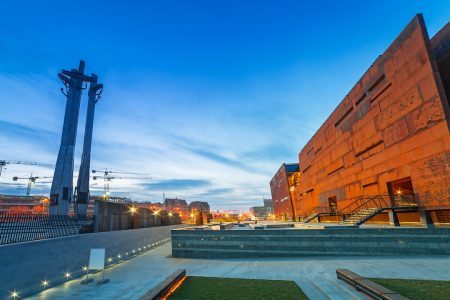What to do on the Baltic sea coast – attractions in Gdansk
Table of Contents
Explore the mighty Old Town of Gdansk
Going on a quick trip and don’t have a lot of time on your hands? If you want to see as many attractions in Gdansk as possible, we advise you to start with the Old Town. Besides being the oldest part of the city, it is arguably the most beautiful. This historic area is home to some stunning buildings that you simply must-see.
Gdansk Old Town is quite unique, especially its market square. Unlike in many other places in Poland, the market is more of a long street, which explains the name ‘Long Market’ (Polish: Długi Targ). Along this central point of the city, you’ll get to see some of the most famous spots in Gdansk like the Golden Gate, Neptune Fountain, St Mary’s Church, the Golden House, the Green Gate and the port Crane.
To soak it all in, make sure to take a leisurely walk along The Royal Way (Polish: Droga Królewska) which encompasses Długa street and the Long Market. Start from the Golden Gate and head towards the Green Gate. The beautifully decorated buildings on each side will make your head spin. If time allows, we recommend simply getting lost in the many streets of Main Town. To ensure you don’t miss anything important, let’s focus on some of the top attractions that you can find.
Admire the Main Town Hall in Gdansk
The Main Town Hall of Gdansk stands in the place where Długa street and Długi Targ merge. Aside from being very impressive to look at from the outside, it is quite magnificent on the inside too. Town Halls are not always points of interest, but this one is different. Stunning rooms (e.g. the Red Room) and a history museum operating inside make this a great attraction. In addition, you can access its tall tower to admire the panorama of the city.
Take a selfie next to the Neptune Fountain
The Neptune Fountain is located right behind the Town Hall and in front of the Artus Court. A photo in front of it is a must for every visitor to Gdansk so don’t pass on it. Just keep in mind that this is probably the most photographed spot in the city so it can become very crowded. There is a sure chance of photobombing. Want to know an interesting fact? As one of the city’s most treasured symbols, this bronze statue was hidden during the Second World War and returned to the Long Market in 1954.

Step inside the towering St Mary’s Church
Dating back to the 14th century, this church is one of the most iconic sights in Gdansk. Don’t quote us on this, but it is believed to be the largest brick church in the world. On top of that, it houses a unique astronomical clock from the 15th century. Want to snap some great panoramic shots of Gdansk? A climb to the top of the church’s tower will be worth it. Just keep in mind there are 400 steps to get there.
Walk along the Motlawa River
Another historic place that you absolutely have to visit is the Motlawa riverside also known as Dlugie Pobrzeze. This place is known for the famous Żuraw (The Crane) which was used to load cargo onto ships. Located next to the Maritime Museum and dating back to 1444, it is the oldest surviving port crane in Europe. When walking along the river be on the lookout for SS Sołdek, a museum ship and the first ship built in Poland after World War II.
Have a leisurely stroll down Mariacka Street
Some people say this is the most Instagram-worthy street in Gdansk so if you want to take that one precious photo from your trip, this is a good spot to try. Located on the other side of St Mary’s Church, Mariacka street is usually filled with stalls where you can buy souvenirs. What makes it special though are the ornate houses and historic gargoyle rain gutters. We think it’s one of the most charming streets in Gdansk, and you?

Learn about the rich history of Gdansk, Poland
Okay, you’ve seen the most beautiful side of Gdansk, but you can’t fully appreciate this city without recognizing its convoluted and fascinating history. If you want to know a bit about this city’s past, here are a few interesting museums that are worth a visit.
Learn about the anti-communist movement at the European Solidarity Centre
In modern times, Gdansk is recognized particularly because of its role in the events of the 2oth century and Poland’s road to freedom. The Shipyard in Gdansk is where the Solidarity movement originated, which ultimately contributed to the end of communism in Poland. The European Solidarity Centre opened in 2014 on the grounds of the shipyard and it’s the best place to learn about what took place there, as well as the movement and its significance not only for Poland but Eastern Europe in general. Since it’s among the best things to do in Gdansk and very popular among tourists, we recommend saving some time and booking tickets in advance. Before entering the building of this centre, the tall sculpture of 3 crosses pegged with anchors will surely catch your attention. This is the Monument of the Fallen Shipyard Workers dedicated to over 40 people who lost their lives in 1970 when protesting against the communist regime.

Spend a few hours in the Museum of the Second World War
Since World War II started with an invasion of Poland and simultaneous attacks on Westerplatte and the Polish Post Office in Gdansk, there’s hardly a better place to create a WWII Museum. Opened in 2017, this museum gives you an opportunity to learn about the war, what led to it and its aftermath. You will also have the chance to see many artefacts and personal belongings from the time. There are numerous exhibitions divided into 3 thematic blocks: The Road to War, The Horrors of War and The War’s Long Shadow. The building is situated just a 10-minute walk from the Crane so it is easy to access on foot. You can expect this stop to take about 3 to 4 hours so make sure to include it in your schedule. The number of people allowed at the same time is limited so if you want to save your spot, booking online is recommended.
Pay your respects at Westerplatte
One of the most popular places to visit while on a trip to Gdansk is the Westerplatte Peninsula. It is believed that the first shots of World War II were fired here. Although today a somber place, Westerplatte Peninsula was once a holiday destination before being converted into a military depot shortly before the war. There were around 200 soldiers who in case of an attack were supposed to resist for 12 hours while waiting for military support from the mainland. Instead, with scarce resources this group of 200 resisted for almost a week until it had to surrender due to lack of ammunition, hunger and exhaustion. The result of the battle of Westerplatte did not have a significant influence on the development of the war, but to this day it is a symbol of Polish resistance and bravery. Today it is a historical park where you can go for a walk while seeing some remnants of the battle that took place, for example, ruins of the barracks. However, its most recognizable sight is the huge Monument of the Coast Defenders erected on a mound.
Venture outside of the Main Town
Once you discovered all the gems along the Royal Way and learned a bit about Gdansk and its background, it’s time to see what other attractions the city has to offer.
Take a moment to relax in the Oliwa Park and step inside Oliwa Cathedral
Take a short tram ride to one of the oldest neighbourhoods in Gdansk. Oliwa is one of the greenest parts of the city so it’s a perfect place if you want to breathe in some fresh air away from the crowds, have a picnic or just lay in the grass. On the grounds of this big park, you’ll find ponds, a botanical garden, a palm house and a Chinese garden. If you’re travelling with children, you can also spend a few hours in the Oliwa zoo, the biggest zoo in Poland.
While you’re in the Oliwa district, step inside the 14th century Oliwa Cathedral known for organ concerts. This gothic church is home to magnificent 18th-century organs which took almost 25 years to build! The best way to experience the organs is to attend one of the numerous summer concerts.

See ‘gold of the Baltic’ at Amber Museum
Any jewellery fans over here? If so, consider a visit to the Amber Museum where you’ll see vast collections of amber jewellery and other artefacts. Amber is a fossilised tree resin and a popular gemstone in the Baltic region. At the Amber Museum, you can find out about how it is extracted and see ways in which it’s used.
Chill on the beach
Don’t leave Gdansk without dipping your toes in the Baltic Sea! Although the neighbouring Sopot is more popular in terms of beach holidays, Gdansk boasts a few beaches of its own. If you’re short on time, you can opt for the beaches closest to Gdansk city centre, such as Jelitkowo and Brzeźno. And if you have an extra day or two, head to Sopot right next to Gdansk where you can walk on the longest wooden pier in Europe.
See a different side of Gdansk
With all the beautiful buildings, historical sights, and beaches, you may have forgotten that Gdansk is a port city. If you venture a bit outside of Main Town, you’ll see its industrial past. In the 20th century, it was home to a large shipyard which many see as the starting point of Poland’s road to freedom. Although not as large these days, parts of the shipyard became a cool place to hang out. Elektryków street is among the most popular locations, especially in the summer when you can sit in a bar and enjoy some street food.
This is for our list of attractions to check out in Gdansk. Believe us that this is just a fraction of what this historic city has to offer. If you’re looking for more ideas on attractions and things to do in Gdansk, check out the tours we offer. With Mr Shuttle you canvisit not only Gdansk but also some places nearby like Malbork Castle or Stutthof Concentration Camp. And if you want to travel in style to Gdansk, Sopot and Gdynia, have a look at our Tricity tour.













